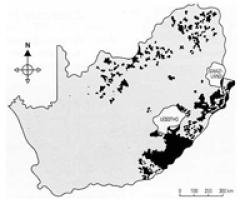
Published date
19 June 1913
The Natives Land Act (No. 27 of 1913) was passed to allocate only about 7% of arable land to Africans and leave the more fertile land for whites. This law incorporated territorial segregation into legislation for the first time since Union in 1910.
The law created reserves for Blacks and prohibited the sale of territory in white areas to Blacks and vice versa. An annexure designated the territory initially allocated to Blacks, with a provision that a commission was to investigate the matter further for a more realistic delimitation. In effect, over 80% went to White people, who made up less than 20% of the population. The Act stipulated that Black people could live outside the reserves only if they could prove that they were in employment. Although the law was applicable to the whole of South Africa, in practice it applied only to the Transvaal and Natal. In the Free State, such legislation was already in force since 1876, while a law forbidding Blacks to own property in the Cape would have been in conflict with the constitution of the Union of South Africa, as Cape property-ownership was one of the qualifications for Black franchise. Sharecropping on farms in the Transvaal and the Orange Free State was forbidden.
According to debates in Parliament, the Act was passed in order to limit friction between White and Black, but Blacks maintained that its aim was to meet demands from White farmers for more agricultural land and force Blacks to work as labourers.
References
Davenport, T.R.H. (1991). South Africa: A modern history, (4th ed), London: Macmillan.|Muller, C.F.J. (ed)(1981). Five Hundred years: a history of South Africa; 3rd rev. ed., Pretoria: Academica, p. 393-96.|Reader's Digest. (1988). Illustrated History of South Africa: the real story, New York: Reader's Digest Association, p. 291-2